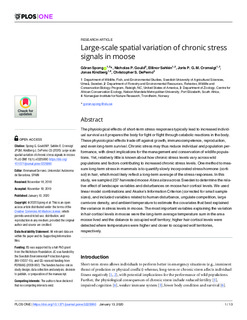| dc.contributor.author | Spong, Göran | |
| dc.contributor.author | Gould, Nicholas P. | |
| dc.contributor.author | Sahlén, Ellinor | |
| dc.contributor.author | Cromsigt, Joris P.G.M. | |
| dc.contributor.author | Kindberg, Jonas | |
| dc.contributor.author | DePerno, Christopher S. | |
| dc.date.accessioned | 2020-02-06T08:34:43Z | |
| dc.date.available | 2020-02-06T08:34:43Z | |
| dc.date.created | 2020-01-27T09:57:32Z | |
| dc.date.issued | 2020 | |
| dc.identifier.issn | 1932-6203 | |
| dc.identifier.uri | http://hdl.handle.net/11250/2639942 | |
| dc.description.abstract | The physiological effects of short-term stress responses typically lead to increased individual survival as it prepares the body for fight or flight through catabolic reactions in the body. These physiological effects trade off against growth, immunocompetence, reproduction, and even long-term survival. Chronic stress may thus reduce individual and population performance, with direct implications for the management and conservation of wildlife populations. Yet, relatively little is known about how chronic stress levels vary across wild populations and factors contributing to increased chronic stress levels. One method to measure long-term stress in mammals is to quantify slowly incorporated stress hormone (cortisol) in hair, which most likely reflect a long-term average of the stress responses. In this study, we sampled 237 harvested moose Alces alces across Sweden to determine the relative effect of landscape variables and disturbances on moose hair cortisol levels. We used linear model combinations and Akaike’s Information Criterion (corrected for small sample sizes), and included variables related to human disturbance, ungulate competition, large carnivore density, and ambient temperature to estimate the covariates that best explained the variance in stress levels in moose. The most important variables explaining the variation in hair cortisol levels in moose were the long-term average temperature sum in the area moose lived and the distance to occupied wolf territory; higher hair cortisol levels were detected where temperatures were higher and closer to occupied wolf territories, respectively. | nb_NO |
| dc.language.iso | eng | nb_NO |
| dc.rights | Navngivelse 4.0 Internasjonal | * |
| dc.rights.uri | http://creativecommons.org/licenses/by/4.0/deed.no | * |
| dc.title | Large-scale spatial variation of chronic stress signals in moose | nb_NO |
| dc.type | Journal article | nb_NO |
| dc.type | Peer reviewed | nb_NO |
| dc.description.version | publishedVersion | nb_NO |
| dc.rights.holder | © 2020 Spong et al. | nb_NO |
| dc.subject.nsi | VDP::Zoologiske og botaniske fag: 480 | nb_NO |
| dc.subject.nsi | VDP::Zoology and botany: 480 | nb_NO |
| dc.source.volume | 15 | nb_NO |
| dc.source.journal | PLOS ONE | nb_NO |
| dc.source.issue | 1 | nb_NO |
| dc.identifier.doi | 10.1371/journal.pone.0225990 | |
| dc.identifier.cristin | 1782480 | |
| dc.relation.project | Andre: Nicholson Foundation | nb_NO |
| dc.relation.project | Andre: Swedish Environmental ProtectionAgency (NV-01337-15) | nb_NO |
| dc.relation.project | Andre: FORMAS (2008-997) | nb_NO |
| cristin.unitcode | 7511,2,0,0 | |
| cristin.unitname | NINA terrestrisk økologi | |
| cristin.ispublished | true | |
| cristin.fulltext | original | |
| cristin.qualitycode | 1 | |

